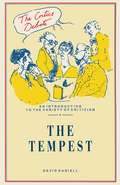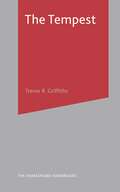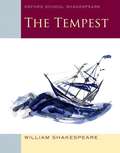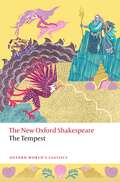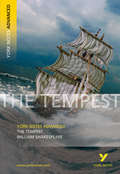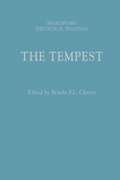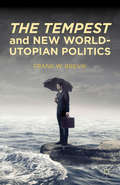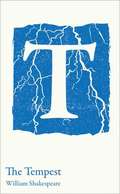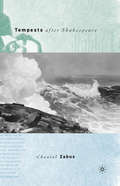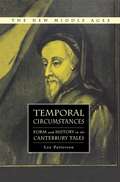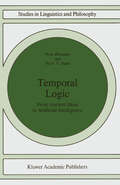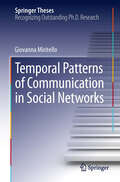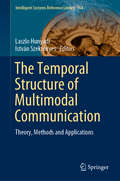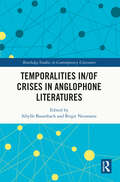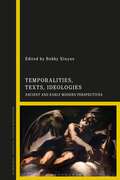- Table View
- List View
The Tempest (The Critics Debate)
by David DaniellPart of a series designed to encourage the student to participate as the critics debate. The first part of this book is a critical survey of ways in which Shakespeare's "The Tempest" has been appraised, followed by the author's own critical appraisals and knowledge of the text.
The Tempest (Shakespeare Handbooks)
by Trevor GriffithsThe commentary at the heart of the book introduces readers to the challenge of reading The Tempest as a text and responding to the play in performance. Other sections discuss early performances and cultural contexts. A wide-ranging sample of critical responses accompanies consideration of key performances and productions on stage and film.
The Tempest (Shakespeare Handbooks)
by Trevor R. GriffithsThe commentary at the heart of the book introduces readers to the challenge of reading The Tempest as a text and responding to the play in performance. Other sections discuss early performances and cultural contexts. A wide-ranging sample of critical responses accompanies consideration of key performances and productions on stage and film.
The Tempest: Oxford School Shakespeare
by William ShakespeareThis edition of The Tempest is especially designed for students, with accessible on-page notes and explanatory illustrations, clear background information, and rigorous but accessible scholarly credentials.This edition includes illustrations, preliminary notes, reading lists (including websites) and classroom notes, allowing students to master Shakespeare's work.
The Tempest
by William ShakespeareThis bewitching play, Shakespeare's final work, articulates a wealth of the playwright's mature reflections on life and contains some of his most familiar and oft-quoted lines. The story concerns Miranda, a lovely young maiden, and Prospero, her philosophical old magician father, who dwell on an enchanted island, alone except for their servants — Ariel, an invisible sprite, and Caliban, a monstrous witch's son. Into their idyllic but isolated lives comes a shipwrecked party that includes the enemies who usurped Prospero's dukedom years before, and set him and his daughter adrift on the ocean. Also among the castaways is a handsome prince, the first young man Miranda has ever seen. Comedy, romance, and reconciliation ensue, in a masterly drama that begins with a storm at sea and concludes in joyous harmony.
The Tempest: The New Oxford Shakespeare (Oxford World's Classics)
by William Shakespeare'How beauteous mankind is! O brave new world That has such people in't!' Performed variously as escapist fantasy, celebratory fiction, and political allegory, The Tempest is one of the plays in which Shakespeare's genius as a poetic dramatist found its fullest expression. Significantly, it was placed first when published in the First Folio of 1623, and is now generally seen as the playwright's most penetrating statement about his art. The New Oxford Shakespeare offers authoritative editions of Shakespeare's works with introductory materials designed to encourage new interpretations of the plays and poems. Using the text from the landmark The New Oxford Shakespeare Complete Works: Modern Critical Edition, these volumes offer readers the latest thinking on the authentic texts (collated from all surviving original versions of Shakespeare's work) alongside innovative introductions from leading scholars. The texts are accompanied by a comprehensive set of critical apparatus to give readers the best resources to help understand and enjoy Shakespeare's work. ABOUT THE SERIES: For over 100 years Oxford World's Classics has made available the widest range of literature from around the globe. Each affordable volume reflects Oxford's commitment to scholarship, providing the most accurate text plus a wealth of other valuable features, including expert introductions by leading authorities, helpful notes to clarify the text, up-to-date bibliographies for further study, and much more.
The Tempest: The New Oxford Shakespeare (Oxford World's Classics)
by William Shakespeare'How beauteous mankind is! O brave new world That has such people in't!' Performed variously as escapist fantasy, celebratory fiction, and political allegory, The Tempest is one of the plays in which Shakespeare's genius as a poetic dramatist found its fullest expression. Significantly, it was placed first when published in the First Folio of 1623, and is now generally seen as the playwright's most penetrating statement about his art. The New Oxford Shakespeare offers authoritative editions of Shakespeare's works with introductory materials designed to encourage new interpretations of the plays and poems. Using the text from the landmark The New Oxford Shakespeare Complete Works: Modern Critical Edition, these volumes offer readers the latest thinking on the authentic texts (collated from all surviving original versions of Shakespeare's work) alongside innovative introductions from leading scholars. The texts are accompanied by a comprehensive set of critical apparatus to give readers the best resources to help understand and enjoy Shakespeare's work. ABOUT THE SERIES: For over 100 years Oxford World's Classics has made available the widest range of literature from around the globe. Each affordable volume reflects Oxford's commitment to scholarship, providing the most accurate text plus a wealth of other valuable features, including expert introductions by leading authorities, helpful notes to clarify the text, up-to-date bibliographies for further study, and much more.
The Tempest: York Notes Advanced (York Notes Advanced)
by William Shakespeare Loreto ToddYork Notes Advanced offer a fresh and accessible approach to English Literature. This market-leading series has been completely updated to meet the needs of today's A-level and undergraduate students. Written by established literature experts, York Notes Advanced intorduce students to more sophisticated analysis, a range of critical perspectives and wider contexts.
The Tempest: A Critical Reader (Arden Early Modern Drama Guides)
by Alden T. Vaughan Virginia Mason VaughanThe Tempest contains sublime poetry and catchy songs, magic and low comedy, while it tackles important contemporary concerns: education, power politics, the effects of colonization, and technology. In this guide, Alden T. Vaughan and Virginia Mason Vaughan open up new ways into one of Shakespeare's most popular, malleable and controversial plays.
The Tempest: A Critical Reader (Arden Early Modern Drama Guides)
by Alden T. Vaughan Virginia Mason VaughanThe Tempest contains sublime poetry and catchy songs, magic and low comedy, while it tackles important contemporary concerns: education, power politics, the effects of colonization, and technology. In this guide, Alden T. Vaughan and Virginia Mason Vaughan open up new ways into one of Shakespeare's most popular, malleable and controversial plays.
The Tempest: Shakespeare: The Critical Tradition (Shakespeare: The Critical Tradition)
The Tempest: Critical Tradition increases our knowledge of how Shakespeare's plays were received and understood by critics, editors and general readers. The volume offers, in separate sections, both critical opinions about the play across the centuries and an evaluation of their positions within and their impact on the reception of the play. The volume features criticism from key literary figures, such as Ben Jonson, Samuel Taylor Coleridge, John Dryden, John Ruskin and Edward Malone. The chronological arrangement of the text-excerpts engages the readers in a direct and unbiased dialogue, whereas the introduction offers a critical evaluation from a current stance, including modern theories and methods. Thus the volume makes a major contribution to our understanding of the play and of the traditions of Shakespearean criticism surrounding it as they have developed from century to century.
The Tempest and New World-Utopian Politics
by F. BrevikThis study on New World-utopian politics in The Tempest traces paradigm shifts in literary criticism over the past six decades that have all but reinscribed the text into a political document. This book challenges the view that the play has a dominant New World dimension and demonstrates through close textual readings how an unstable setting at the same time enables and effaces discursively over-invested New World interpretations. Almost no critical attention has been paid to the play's vacuum of power, and this work interprets pastoral, utopian, and 'American' tensions in light of the play's forever-ambiguous setting as well as through a 'presentist' post-1989 lens, an oft-neglected historical and political paradigm shift in Shakespeare criticism.
The Tempest (Collins Classroom Classics) (PDF)
by William Shakespeare Peter Alexander Lucy Toop Mike GouldExam board: AQA, Edexcel; CXC Level & Subject: GCSE 9-1 English Literature; CSEC® English B First teaching: September 2015 First examination: June 2017 This edition of The Tempest is perfect for GCSE-level students, with the complete play in an accessible format, on-page notes, introduction setting the context, timeline, character and theme indexes.
Tempests after Shakespeare
by C. ZabusTempests After Shakespeare shows how the 'rewriting' of Shakespeare's play serves as an interpretative grid through which to read three movements - postcoloniality, postpatriarchy, and postmodernism - via the Tempest characters of Caliban, Miranda/Sycorax and Prospero, as they vie for the ownership of meaning at the end of the twentieth century. Covering texts in three languages, from four continents and in the last four decades, this study imaginatively explores the collapse of empire and the emergence of independent nation-states; the advent of feminism and other sexual liberation movements that challenged patriarchy; and the varied critiques of representation that make up the 'postmodern condition'.
The Temple of Culture: Assimilation and Anti-Semitism in Literary Anglo-America
by Jonathan FreedmanFrom the beginning of modern intellectual history to the culture wars of the present day, the experience of assimilating Jews and the idiom of "culture" have been fundamentally intertwined with each other. Freedman's book begins by looking at images of the stereotypical Jew in the literary culture of nineteenth- and twentieth-century England and America, and then considers the efforts on the part of Jewish critics and intellectuals to counter this image in the public sphere. It explores the unexpected parallels and ironic reversals between a cultural dispensation that had ambivalent responses to Jews and Jews who became exponents of that very tradition.
Temporal Circumstances: Form and History in the Canterbury Tales (The New Middle Ages)
by L. PattersonTemporal Circumstances provides powerful and detailed interpretations of the most important and challenging of the Canterbury Tales. Well-informed and clearly written, this book will interest both those familiar with Chaucer's masterpiece and readers new to it.
Temporal Experience: The Atomist Dynamic Model (Oxford Studies of Time in Language and Thought #6)
by Prof Giuliano TorrengoMany physical theories suggest that time does not pass, yet temporality deeply permeates our experience. We perceive change and movement, we are aware of living in the present, of the constant flux of our sensations and thoughts, and of time itself flowing. In Temporal Experience, Torrengo considers the core facts of temporal experience and their interconnections, ultimately defending the atomist dynamic model of temporal experience. The book critically examines prevalent theories of experience of change, succession, and passage of time both in philosophy and psychology. Each chapter contributes to the construction of the atomist dynamic model. Experience of change and movement are explained through mental events that present virtually instantaneous movement and change. Torrengo challenges the common belief in the perception of 'presentness' and proposes an error theory based on narrative cognition. The experience of succession is elucidated through the concept of an overarching phenomenology, arguing against the tendency to overstate the phenomenal continuity of experience. Finally, the experience of the passage of time is approached through the non-representationalist theory of the phenomenal modifier, and the book concludes by discussing the surprising consequences of applying the experiential model defended to the scientific image of our existence in time as a sequence of physical events.
Temporal Experience: The Atomist Dynamic Model (Oxford Studies of Time in Language and Thought #6)
by Prof Giuliano TorrengoMany physical theories suggest that time does not pass, yet temporality deeply permeates our experience. We perceive change and movement, we are aware of living in the present, of the constant flux of our sensations and thoughts, and of time itself flowing. In Temporal Experience, Torrengo considers the core facts of temporal experience and their interconnections, ultimately defending the atomist dynamic model of temporal experience. The book critically examines prevalent theories of experience of change, succession, and passage of time both in philosophy and psychology. Each chapter contributes to the construction of the atomist dynamic model. Experience of change and movement are explained through mental events that present virtually instantaneous movement and change. Torrengo challenges the common belief in the perception of 'presentness' and proposes an error theory based on narrative cognition. The experience of succession is elucidated through the concept of an overarching phenomenology, arguing against the tendency to overstate the phenomenal continuity of experience. Finally, the experience of the passage of time is approached through the non-representationalist theory of the phenomenal modifier, and the book concludes by discussing the surprising consequences of applying the experiential model defended to the scientific image of our existence in time as a sequence of physical events.
Temporal Logic: From Ancient Ideas to Artificial Intelligence (Studies in Linguistics and Philosophy #57)
by Peter Øhrstrøm Per HasleTemporal Logic: From Ancient Ideas to Artificial Intelligence deals with the history of temporal logic as well as the crucial systematic questions within the field. The book studies the rich contributions from ancient and medieval philosophy up to the downfall of temporal logic in the Renaissance. The modern rediscovery of the subject, which is especially due to the work of A. N. Prior, is described, leading into a thorough discussion of the use of temporal logic in computer science and the understanding of natural language. Temporal Logic: From Ancient Ideas to Artificial Intelligence thus interweaves linguistic, philosophical and computational aspects into an informative and inspiring whole.
Temporal Patterns of Communication in Social Networks (Springer Theses)
by Giovanna MiritelloThe main interest of this research has been in understanding and characterizing large networks of human interactions as continuously changing objects. In fact, although many real social networks are dynamic networks whose elements and properties continuously change over time, traditional approaches to social network analysis are essentially static, thus neglecting all temporal aspects. Specifically, we have investigated the role that temporal patterns of human interaction play in three main fields of social network analysis and data mining: characterization of time (or attention) allocation in social networks, prediction of link decay/persistence, and information spreading. In order to address this we analyzed large anonymized data sets of phone call communication traces over long periods of time. Access to these observations was granted by Telefonica Research, Spain. The findings that emerge from our research indicate that the observed heterogeneities and correlations of human temporal patterns of interaction significantly affect the traditional view of social networks, shifting from a very steady to a highly complex entity. Since structure and dynamics are tightly coupled, they cannot be disentangled in the analysis and modeling of human behavior, though traditional models seek to do so. Our results impact not only the way in which social network are traditionally characterized, but more importantly also the understanding and modeling phenomena such as group formation, spread of epidemics, and the dissemination of ideas, opinions and information.
The Temporal Structure of Multimodal Communication: Theory, Methods and Applications (Intelligent Systems Reference Library #164)
by Laszlo Hunyadi István SzekrényesThe general focus of this book is on multimodal communication, which captures the temporal patterns of behavior in various dialogue settings. After an overview of current theoretical models of verbal and nonverbal communication cues, it presents studies on a range of related topics: paraverbal behavior patterns in the classroom setting; a proposed optimal methodology for conversational analysis; a study of time and mood at work; an experiment on the dynamics of multimodal interaction from the observer’s perspective; formal cues of uncertainty in conversation; how machines can know we understand them; and detecting topic changes using neural network techniques. A joint work bringing together psychologists, communication scientists, information scientists and linguists, the book will be of interest to those working on a wide range of applications from industry to home, and from health to security, with the main goals of revealing, embedding and implementing a rich spectrum of information on human behavior.
Temporalities in/of Crises in Anglophone Literatures (Routledge Studies in Contemporary Literature)
by Sibylle Baumbach Birgit NeumannLiterary works play a crucial role in modelling and conceptualising temporalities. This becomes particularly apparent in times of crises, which put conventionalised temporal patterns and routines under pressure. During crises, past, present, and future appear to collapse into each other and give way to temporal disjunction and rupture. Offering pluralised and context-sensitive approaches to temporalities in and of crises, this volume explores how literature’s engagement with crises suggests both the need for and possibility of rethinking ‘time’. The volume is committed to examining the affordances of specific genres and their potential in pointing beyond temporalities of crises to facilitate a sense of futurity. Individual essays are grounded in recent theories of temporality and literary form, which are related to novel advancements in ecocriticism, queer studies, affect theory, and postcolonial studies. The chapters cover a broad range of examples from different literary genres to reveal the knowledge of literature about temporalities in and of crises.
Temporalities in/of Crises in Anglophone Literatures (Routledge Studies in Contemporary Literature)
Literary works play a crucial role in modelling and conceptualising temporalities. This becomes particularly apparent in times of crises, which put conventionalised temporal patterns and routines under pressure. During crises, past, present, and future appear to collapse into each other and give way to temporal disjunction and rupture. Offering pluralised and context-sensitive approaches to temporalities in and of crises, this volume explores how literature’s engagement with crises suggests both the need for and possibility of rethinking ‘time’. The volume is committed to examining the affordances of specific genres and their potential in pointing beyond temporalities of crises to facilitate a sense of futurity. Individual essays are grounded in recent theories of temporality and literary form, which are related to novel advancements in ecocriticism, queer studies, affect theory, and postcolonial studies. The chapters cover a broad range of examples from different literary genres to reveal the knowledge of literature about temporalities in and of crises.
Temporalities, Texts, Ideologies: Ancient and Early Modern Perspectives
by Bobby XinyueTemporalities, Texts, Ideologies provides a new analysis of the significance of time in Classical and early modern literature, demonstrating that literary temporality continually intervenes in questions of ontology, hierarchy and politics. Examining a diverse range of texts from Homeric epic to eighteenth-century poems on the Last Judgement, this collection of essays contends that temporality in literature sits at the heart of how authors from antiquity through to the early modern period understood and negotiated the structures that shaped their lives and may shape lives to come.Approaching the topic through four themes, the essays in this volume highlight the ways in which time is construed as relational, contestable and politically inflected. The authors show that variations in temporalities enable texts to critique the interactions or tensions between tradition and change, agency and determinism, social system and individual experience. The result is a refreshing approach to literary figurations of time that responds to the recent 'temporal turn' in the humanities, engages with current critical trends (such as ontological analysis and ecological criticism), and opens up an exciting new direction for future research on the connection between time, text, and context.
